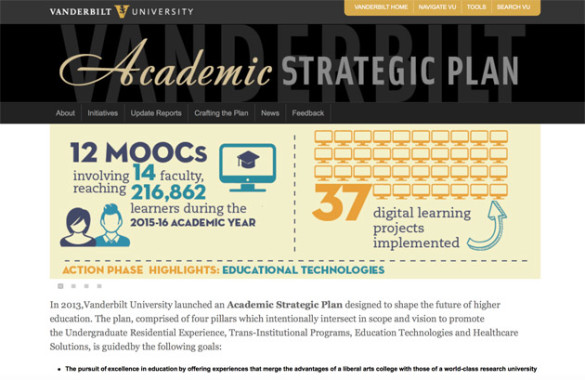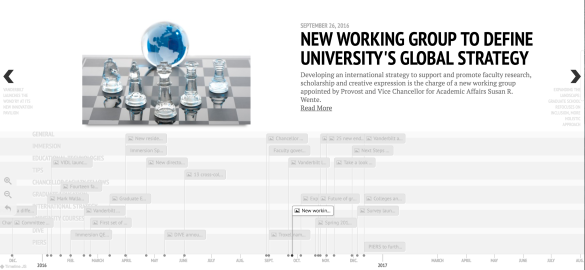
The website for Vanderbilt’s Academic Strategic Plan has been updated to promote some of the major accomplishments achieved thus far and to preview programs and initiatives in development.
The Academic Strategic Plan is designed to guide university investments in faculty recruitment, capital planning, academic programs and philanthropic priorities over the next decade. The strategic planning process was launched in summer 2013 with the Vision Phase and moved into the Action Phase in October 2014. As the Action Phase continues, efforts under the Impact Phase have launched as well and include tracking and measuring progress and refining efforts to ensure the university is in alignment with the strategic plan moving forward.
Unveiled in mid-December, the revamped website details the significance of the plan and spotlights many of the initiatives and programs that have been realized since its inception. These efforts are wide ranging and demonstrate the holistic vision the plan has created for the university and the future of higher education.
“The Academic Strategic Plan continues to spark great creativity and collaboration in terms of motivating our faculty, staff and students, setting ambitious priorities, launching bold initiatives and identifying valuable resources to bring the plan’s vision to fruition,” Provost and Vice Chancellor for Academic Affairs Susan R. Wente said. “The programs initiated by the plan represent some of the great strides Vanderbilt is making to support faculty research and innovation, as well as immersive educational experiences among students and much more.”
Trans-Institutional Programs (TIPs), University Courses, Immersion Vanderbilt and Chancellor Faculty Fellows are among the initiatives that have been created thanks to the vision outlined by the Academic Strategic Plan. Other initiatives highlighted by the website include Educational Technologies, Graduate Education, the Immersion Vanderbilt Quality Enhancement Plan (QEP), the Provost’s Initiatives to Enhance Research and Scholarship (PIERS) and International Strategy. The website will continue to be updated regularly as current initiatives develop and new ones are added.
The main navigation bar that runs horizontally along the top of the webpage features links to each of the featured initiatives, a comprehensive history of the plan’s development, quarterly update reports, news about the plan, a feedback page and more.
One of the most distinctive features of the new homepage is an interactive timeline that chronicles major milestones, providing a visual history through which readers can scroll. Each of the initiatives has a section within the timeline, allowing users to easily find items that pertain specifically to that part of the plan. Additionally, each initiative page includes its own timeline, tailored with content directly related to the specific program.
The rotating slide show feature near the top of the homepage has been updated to include four infographic images that highlight Action Phase accomplishments from each of the plan’s four pillars—Undergraduate Residential Experience, Trans-Institutional Programs, Education Technologies and Healthcare Solutions.
The new Academic Strategic Plan homepage also includes informational boxes about each of the eight featured initiatives, with each box containing a descriptive paragraph along with a link to an “Initiative Overview” page that users can visit to learn more about each program. When applicable, each box also features a “website” button that users can click to visit the initiative’s stand-alone website outside of the Academic Strategic Plan site. Each initiative overview page includes a description of the program, information and/or links to relevant committees, applicable reports and an interactive timeline of key milestones and accomplishments.
To learn more, visit the Academic Strategic Plan website.
The ASP website was developed by University Web Communications in collaboration with the Office of the Provost.
